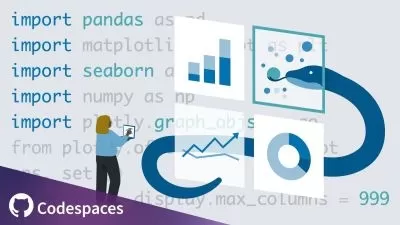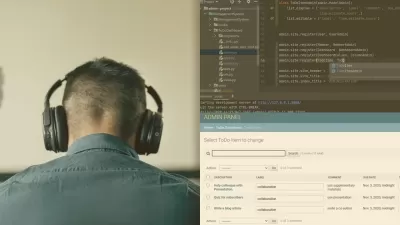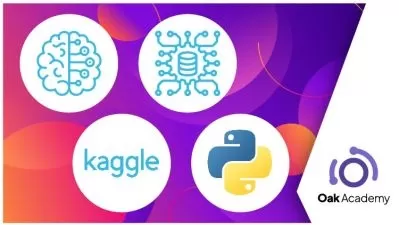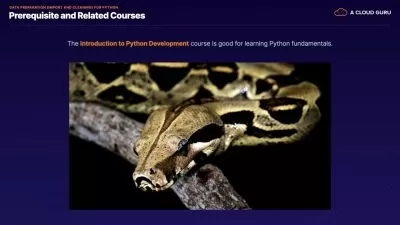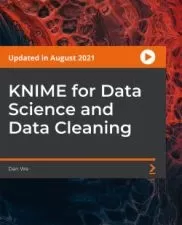Python Data Science: Unsupervised Machine Learning
Maven Analytics,Alice Zhao
16:42:30
Description
Learn Python for data science & machine learning, and build unsupervised learning models w/ a top Python instructor!
What You'll Learn?
- Master the foundations of unsupervised Machine Learning in Python, including clustering, anomaly detection, dimensionality reduction, and recommenders
- Prepare data for modeling by applying feature engineering, selection, and scaling
- Fit, tune, and interpret three types of clustering algorithms: K-Means Clustering, Hierarchical Clustering, and DBSCAN
- Use unsupervised learning techniques like Isolation Forests and DBSCAN for anomaly detection
- Apply and interpret two types of dimensionality reduction models: Principal Component Analysis (PCA) and t-SNE
- Build recommendation engines using content-based and collaborative filtering techniques, including Cosine Similarity and Singular Value Decomposition (SVD)
Who is this for?
What You Need to Know?
More details
DescriptionThis is a hands-on, project-based course designed to help you master the foundations for unsupervised machine learning in Python.
We’ll start by reviewing the Python data science workflow, discussing the techniques & applications of unsupervised learning, and walking through the data prep steps required for modeling. You’ll learn how to set the correct row granularity for modeling, apply feature engineering techniques, select relevant features, and scale your data using normalization and standardization.
From there we'll fit, tune, and interpret 3 popular clustering models using scikit-learn. We’ll start with K-Means Clustering, learn to interpret the output’s cluster centers, and use inertia plots to select the right number of clusters. Next, we’ll cover Hierarchical Clustering, where we’ll use dendrograms to identify clusters and cluster maps to interpret them. Finally, we’ll use DBSCAN to detect clusters and noise points and evaluate the models using their silhouette score.
We’ll also use DBSCAN and Isolation Forests for anomaly detection, a common application of unsupervised learning models for identifying outliers and anomalous patterns. You’ll learn to tune and interpret the results of each model and visualize the anomalies using pair plots.
Next, we’ll introduce the concept of dimensionality reduction, discuss its benefits for data science, and explore the stages in the data science workflow in which it can be applied. We’ll then cover two popular techniques: Principal Component Analysis, which is great for both feature extraction and data visualization, and t-SNE, which is ideal for data visualization.
Last but not least, we’ll introduce recommendation engines, and you'll practice creating both content-based and collaborative filtering recommenders using techniques such as Cosine Similarity and Singular Value Decomposition.
Throughout the course you'll play the role of an Associate Data Scientist for the HR Analytics team at a software company trying to increase employee retention. Using the skills you learn throughout the course, you'll use Python to segment the employees, visualize the clusters, and recommend next steps to increase retention.
COURSEÂ OUTLINE:
Intro to Data Science in Python
Introduce the fields of data science and machine learning, review essential skills, and introduce each phase of the data science workflow
Unsupervised Learning 101
Review the basics of unsupervised learning, including key concepts, types of techniques and applications, and its place in the data science workflow
Pre-Modeling Data Prep
Recap the data prep steps required to apply unsupervised learning models, including restructuring data, engineering & scaling features, and more
Clustering
Apply three different clustering techniques in Python and learn to interpret their results using metrics, visualizations, and domain expertise
Anomaly Detection
Understand where anomaly detection fits in the data science workflow, and apply techniques like Isolation Forests and DBSCAN in Python
Dimensionality Reduction
Use techniques like Principal Component Analysis (PCA) and t-SNE in Python to reduce the number of features in a data set without losing information
Recommenders
Recognize the variety of approaches for creating recommenders, then apply unsupervised learning techniques in Python, including Cosine Similarity and Singular Vector Decomposition (SVD)
__________
Ready to dive in? Join today and get immediate, LIFETIME access to the following:
16.5 hours of high-quality video
22 homework assignments
7 quizzes
3 projects
Python Data Science: Unsupervised Learning ebook (350+Â pages)
Downloadable project files &Â solutions
Expert support and Q&AÂ forum
30-day Udemy satisfaction guarantee
If you're a business intelligence professional or data scientist looking for a practical overview of unsupervised learning techniques in Python with a focus on interpretation, this is the course for you.
Happy learning!
-Alice Zhao (Python Expert & Data Science Instructor, Maven Analytics)
__________
Looking for our full business intelligence stack? Search for "Maven Analytics" to browse our full course library, including Excel, Power BI, MySQL, Tableau and Machine Learning courses!
See why our courses are among the TOP-RATEDÂ on Udemy:
"Some of the BESTÂ courses I've ever taken. I've studied several programming languages, Excel, VBA and web dev, and Maven is among the very best I've seen!" Russ C.
"This is my fourth course from Maven Analytics and my fourth 5-star review, so I'm running out of things to say. I wish Maven was in my life earlier!" Tatsiana M.
"Maven Analytics should become the new standard for all courses taught on Udemy!" Jonah M.
Who this course is for:
- Data scientists who want to learn how to build and interpret unsupervised learning models in Python
- Analysts or BI experts looking to learn about unsupervised learning or transition into a data science role
- Anyone interested in learning one of the most popular open source programming languages in the world
This is a hands-on, project-based course designed to help you master the foundations for unsupervised machine learning in Python.
We’ll start by reviewing the Python data science workflow, discussing the techniques & applications of unsupervised learning, and walking through the data prep steps required for modeling. You’ll learn how to set the correct row granularity for modeling, apply feature engineering techniques, select relevant features, and scale your data using normalization and standardization.
From there we'll fit, tune, and interpret 3 popular clustering models using scikit-learn. We’ll start with K-Means Clustering, learn to interpret the output’s cluster centers, and use inertia plots to select the right number of clusters. Next, we’ll cover Hierarchical Clustering, where we’ll use dendrograms to identify clusters and cluster maps to interpret them. Finally, we’ll use DBSCAN to detect clusters and noise points and evaluate the models using their silhouette score.
We’ll also use DBSCAN and Isolation Forests for anomaly detection, a common application of unsupervised learning models for identifying outliers and anomalous patterns. You’ll learn to tune and interpret the results of each model and visualize the anomalies using pair plots.
Next, we’ll introduce the concept of dimensionality reduction, discuss its benefits for data science, and explore the stages in the data science workflow in which it can be applied. We’ll then cover two popular techniques: Principal Component Analysis, which is great for both feature extraction and data visualization, and t-SNE, which is ideal for data visualization.
Last but not least, we’ll introduce recommendation engines, and you'll practice creating both content-based and collaborative filtering recommenders using techniques such as Cosine Similarity and Singular Value Decomposition.
Throughout the course you'll play the role of an Associate Data Scientist for the HR Analytics team at a software company trying to increase employee retention. Using the skills you learn throughout the course, you'll use Python to segment the employees, visualize the clusters, and recommend next steps to increase retention.
COURSEÂ OUTLINE:
Intro to Data Science in Python
Introduce the fields of data science and machine learning, review essential skills, and introduce each phase of the data science workflow
Unsupervised Learning 101
Review the basics of unsupervised learning, including key concepts, types of techniques and applications, and its place in the data science workflow
Pre-Modeling Data Prep
Recap the data prep steps required to apply unsupervised learning models, including restructuring data, engineering & scaling features, and more
Clustering
Apply three different clustering techniques in Python and learn to interpret their results using metrics, visualizations, and domain expertise
Anomaly Detection
Understand where anomaly detection fits in the data science workflow, and apply techniques like Isolation Forests and DBSCAN in Python
Dimensionality Reduction
Use techniques like Principal Component Analysis (PCA) and t-SNE in Python to reduce the number of features in a data set without losing information
Recommenders
Recognize the variety of approaches for creating recommenders, then apply unsupervised learning techniques in Python, including Cosine Similarity and Singular Vector Decomposition (SVD)
__________
Ready to dive in? Join today and get immediate, LIFETIME access to the following:
16.5 hours of high-quality video
22 homework assignments
7 quizzes
3 projects
Python Data Science: Unsupervised Learning ebook (350+Â pages)
Downloadable project files &Â solutions
Expert support and Q&AÂ forum
30-day Udemy satisfaction guarantee
If you're a business intelligence professional or data scientist looking for a practical overview of unsupervised learning techniques in Python with a focus on interpretation, this is the course for you.
Happy learning!
-Alice Zhao (Python Expert & Data Science Instructor, Maven Analytics)
__________
Looking for our full business intelligence stack? Search for "Maven Analytics" to browse our full course library, including Excel, Power BI, MySQL, Tableau and Machine Learning courses!
See why our courses are among the TOP-RATEDÂ on Udemy:
"Some of the BESTÂ courses I've ever taken. I've studied several programming languages, Excel, VBA and web dev, and Maven is among the very best I've seen!" Russ C.
"This is my fourth course from Maven Analytics and my fourth 5-star review, so I'm running out of things to say. I wish Maven was in my life earlier!" Tatsiana M.
"Maven Analytics should become the new standard for all courses taught on Udemy!" Jonah M.
Who this course is for:
- Data scientists who want to learn how to build and interpret unsupervised learning models in Python
- Analysts or BI experts looking to learn about unsupervised learning or transition into a data science role
- Anyone interested in learning one of the most popular open source programming languages in the world
User Reviews
Rating
Maven Analytics
Instructor's CoursesAlice Zhao
Instructor's Courses
Udemy
View courses Udemy- language english
- Training sessions 199
- duration 16:42:30
- Release Date 2024/06/25









